Ginger is a commonly used spicy plant. Tea made from it with honey and lemon is a powerful antiviral drug that can help with colds and flu. We usually buy ginger in the store, but it is easy to grow it at home. About how to grow ginger at home, you will learn from this article.
Material Content:
Features of growing ginger at home
This plant is a resident of tropical countries. It is hot there and a lot of moisture, therefore, the apartment will need to create similar conditions for the plant. In the tropics and subtropics, ginger is a perennial. In the apartment and in the open field, it is usually grown in an annual culture.
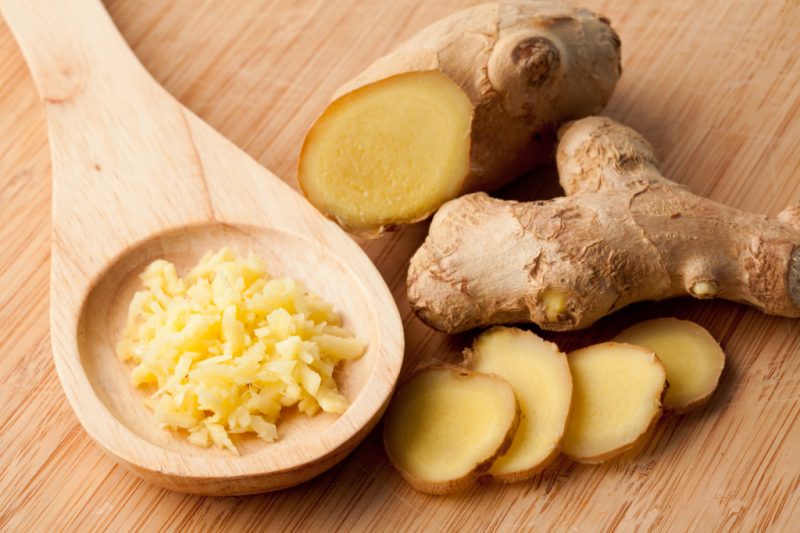
If you want the plant to overwinter and please the flowering, which happens only in the second year, you can dig up the rhizome grown in the garden and transplant it into a pot. Ginger root is fibrous - in a pot it will feel good. You just need to remember that ginger can grow to a meter or more in height, because the plant needs to choose the appropriate place where it will be spacious.
Preparation for landing
To grow ginger from the root, you must first prepare it. Like any cultivated plant, ginger has various varieties for growing. Some of them not only give a good harvest of rhizomes, but also have a long, beautiful flowering, and therefore can serve as a decorative element of the flower garden.
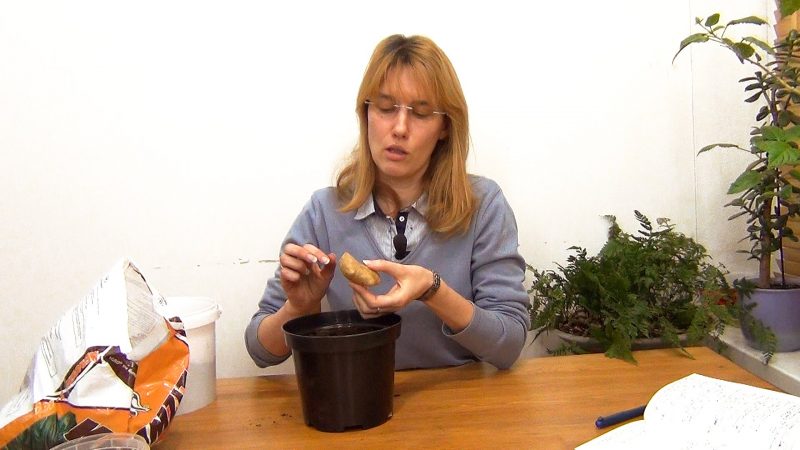
- Zerumbet - has flowers similar to roses.
- Wonderful - characterized by long flowering scarlet flowers.
- Kasumunar - its white flowers look like orchids.
- Purple - powerful stems bear peduncles with decorative flowers.
- Japanese - blooms in the early stages, the flowers have a fragrance.
Of course, in the store you can hardly find out which variety the selected root belongs to. Growing it as an ornamental plant is fraught with great difficulties: you need to withstand a certain temperature, humidity, and other parameters. It is difficult to keep all this in the apartment. Therefore, we restrict ourselves to growing spicy rhizomes. By the way, they are the tastiest in the first year of life, and with further cultivation they not only become coarse, but also acquire excessive bitterness.
To grow ginger from the root, you need to choose it and prepare it correctly. Choose a rhizome with a lot of eyes. The lighter the peel, the less it was stored. Sometimes on sale you can find peeled and processed in a special way rhizome - it is not suitable for planting.
Root soaking
In order for the eyes to sprout as soon as possible, the rhizome must be “woken up”, since during storage it dries out a little. It is enough to soak it for 2-3 hours (the water for this is taken warm).

Further preparation process:
- cut into jumpers so that at least one kidney is on each piece;
- disinfect rhizome pieces in a slightly pink solution of potassium permanganate;
- sprinkle the slices with crushed coal.
Disembarkation
For planting, a large diameter pot is selected so that the rhizomes have room to grow and of sufficient height if ginger has been growing in the room for more than one year. For growing ginger at home on a windowsill, nutritious garden soil or any purchased soil for garden crops is suitable, the main thing is that it be loose and have a neutral reaction.
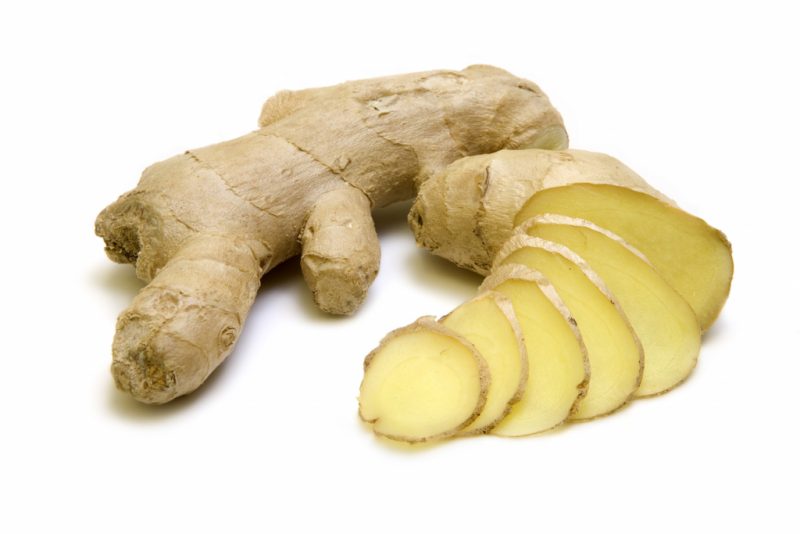
- We spill the soil with the Fitosporin solution.
- Be sure to place drainage at the bottom of the pot.
- Do not forget about the hole for the drain of water.
- A piece of tuber or a whole rhizome is placed in moist soil to a depth of about 2 cm with the kidney up.
Ginger seedlings
We are waiting for seedlings, from time to time moistening the soil in a pot. This usually takes about a month. All this time the pot should be in the light and warm. With severe dry air in the apartment, you can put a plastic bag on the pot. This procedure will not only provide greenhouse conditions for plantings, but also accelerate the emergence of seedlings by 2 weeks. If planting was carried out at the end of winter or early spring, then there is a chance not only to get a crop of rhizomes, but also to see the flowering plant.
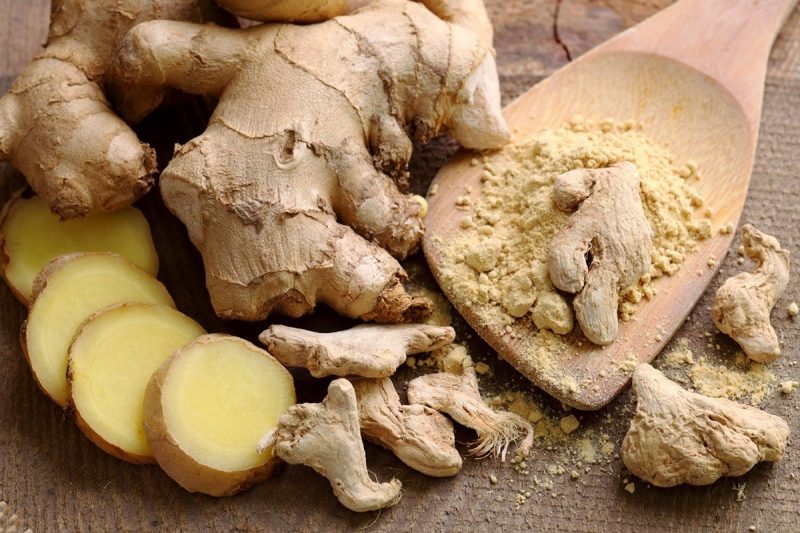
Home-grown Ginger Care
For a plant to develop well, it needs conditions close to natural.
Special conditions: lighting, temperature
The temperature range from 25 to 33 degrees Celsius is considered comfortable for ginger, but he does not like sudden changes in temperature. The best light for him is diffused, and the midday bright sunlight will not do any good for ginger. Therefore, we choose for its cultivation the windowsill of the window oriented to the east. In the warm summer, he will feel good on the loggia or even in the garden, if you protect him from the scorching sun and strong wind.

Watering, top dressing, cultivation
Ginger loves moisture, but its stagnation can cause root rot. The soil in the pot should always be slightly moist, because the higher the temperature, the more often you need to water the plant. In mid-autumn, watering is reduced by drying an earthen lump - so rhizomes will gain a large mass.

Ginger is fed with full mineral fertilizer with a frequency of once every 2-3 weeks. It must be combined with watering. Ginger gratefully responds to spraying with warm water.
If a plant is grown for flowering in a fertilizer mixture, phosphorus should prevail, for the formation of rhizomes, it needs more potassium.
In order for air to flow freely to the roots, the earth in the pot is loosened every week, but not deep, so as not to disturb the growing rhizomes. With good care, the plant quickly grows leaves, which, by the way, can be eaten.It’s not worth zealous for cutting them off, otherwise the growing rhizomes will not have enough nutrition, they will grow more slowly and become small.
Ginger Harvest
In order for full-grown rhizomes to grow, ginger needs about 8 months. Usually in autumn, the plant begins to prepare for the dormant period - the stems fall apart, the leaves turn yellow and fall off. If you want the plant to winter, take it out to a room with a temperature of about 15 degrees. Neither light nor fertilizing is needed at this time. It is enough to slightly moisten the earthen lump several times during the winter.
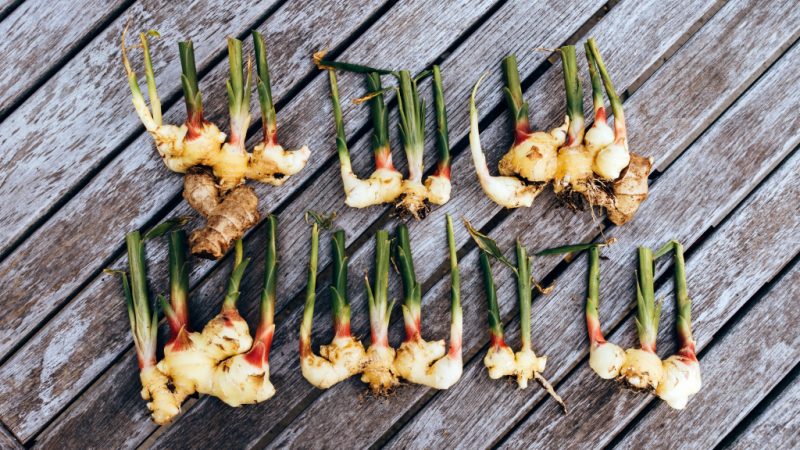
If the purpose of the cultivation was to obtain a crop, rhizomes need to be dug up, freed from the additional roots and dried. Dig out the rhizomes with your hands, so as not to damage them.
Rules for outdoor cultivation
They are no more complicated than when grown in a room.
In warm regions, the plant will be comfortable without any shelter when planting directly in the ground. In a cool climate, it is better to grow ginger in a greenhouse, planting it for preliminary germination in the middle of winter in pots at home.
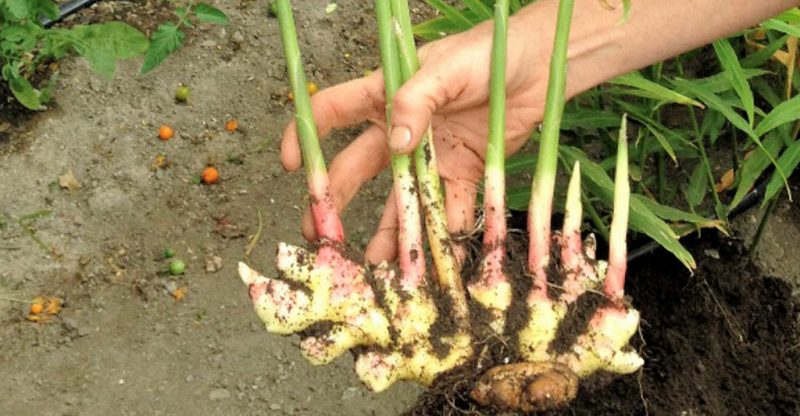
Growing Rules:
- we select a place in the partial shadow of other cultures, but with enough diffused light;
- the soil should be fertile, so we season it with humus and full mineral fertilizer;
- if the soil is light, you can do without drainage, otherwise, on the bottom of the pit with a depth of 20 cm, we put small pebbles and a layer of sand, the thickness of both is 2 cm;
- we fill the holes with soil and plant grown plants, watering them well;
- water the plants as necessary, preventing the soil from drying out;
- we feed 2 times a month with organic fertilizers or herbal infusion;
- in August we carry out top dressing with potassium sulfate;
- from the beginning of September we stop watering.
How to protect ginger from diseases and pests?
Ginger is quite resistant to diseases and, with proper care, does not suffer from them. Of the pests, the scourge of all house plants - the spider mite - can annoy him. The most radical way to deal with it is to spray with acaricides. But for a culture used in food, this is not desirable. Therefore, you can arrange a shower every 2 weeks with hot (but not higher than 40 degrees) water with washing the leaves with soap and water.
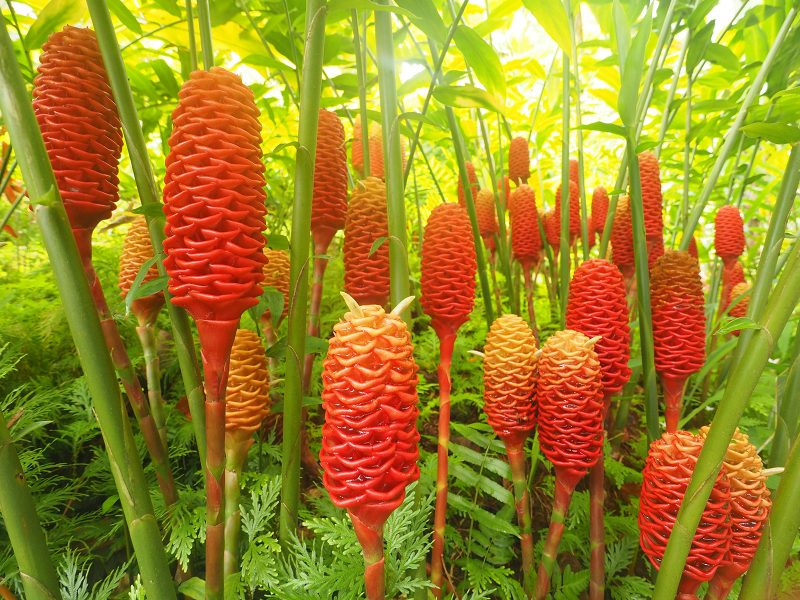
A good way is to wipe the leaves and stems with alcohol at 96% concentration. This procedure is carried out quickly so as not to burn the plants.
Growing ginger at home and on the street is a fascinating activity, and a good harvest of rhizomes will provide an environmentally friendly food product for a long time.












